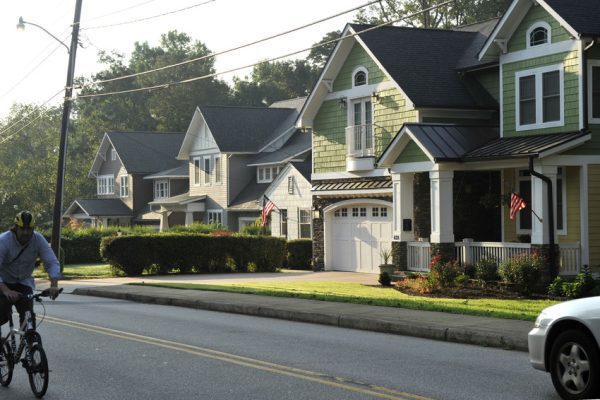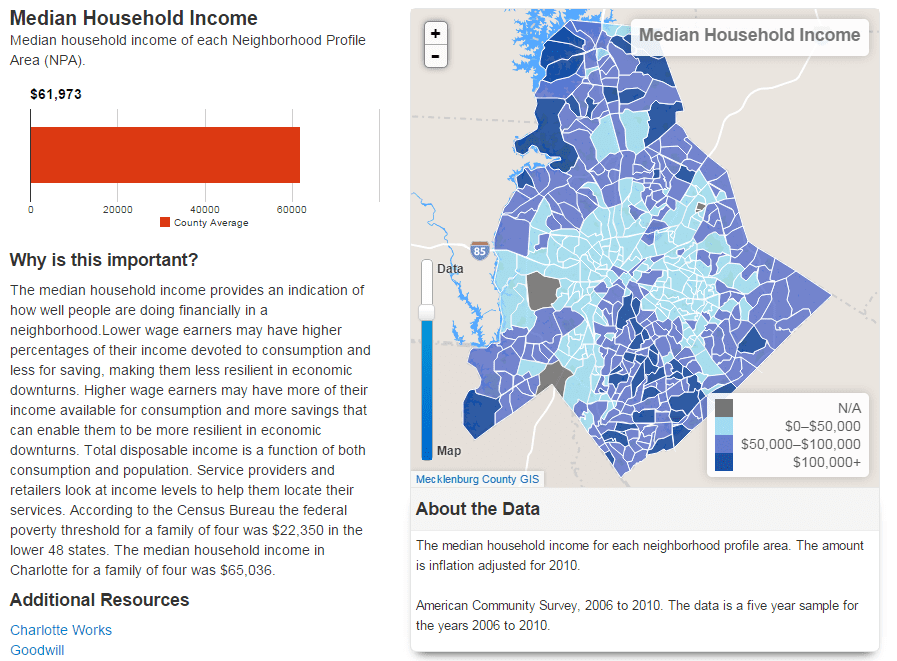Charlotte part of national effort on neighborhood data

You don’t attend many conferences where the first question you are asked is, “What’s your favorite dataset?”
However, that was the question we heard when we represented Charlotte at the National Neighborhood Indicators Partnership (NNIP) conference in Denver. The UNC Charlotte Urban Institute, along with the City of Charlotte and Mecklenburg County, partnered to join NNIP earlier this year, so this meeting was Charlotte’s coming-out party of sorts as the newest partner.
|
Tools for data-sharing Some new options for presenting data: HighCharts, Bootleaf, and Mapbox, which make interactive charts and maps. Creating data stories is harder than it appears. ProvPlan and NeighborhoodInfo DC, are examples of sites with compelling data stories we hope to emulate in Charlotte. |
Coordinated by The Urban Institute (based in Washington), NNIP is a national learning network of nearly 40 partners that maintain neighborhood and integrated data systems and also encourage the use of data in local policymaking and community building. Through this invitation-only network, partners share knowledge and discover ways to better serve their communities. One of the main ways these discoveries take place is through NNIP’s twice yearly conferences.
The fall 2014 conference was hosted by the Piton Foundation, the Denver NNIP partner, and featured sessions in a variety of different formats like ignite presentations, unconference sessions (where the agenda is created by the attendees), and panel discussions.
Other Charlotteans at the conference were Rebecca Hefner, community information and research manager at the City of Charlotte, and Timmothy Tibbs, assistant to the Mecklenburg County manager.
Together, we gave an introductory presentation on the Charlotte partnership, telling our peers about our city, the unique collaborative spirit between our organizations and the work we are doing around data using the Quality of Life Project, the Regional Indicators project, and the ISC Community database. The Quality of Life Project pairs the university with both the city and county government to assess the health of neighborhoods in Charlotte and Mecklenburg County. The Regional Indicators project is the institute’s regional data portal. The ISC Community Database pairs the institute and regional social and human service organizations on a collaborative community database for planning and evaluation. Our multi-organization partnership that blends local government with university organizations is a novel one. Other partners were intrigued by our shared structure.
Reflecting on the group’s presentation, Timmothy Tibbs said, “I was very proud that our project(s) and even the uniqueness of our structure, could be models for other areas to emulate. While local governments aren’t a typical partner, we have the opportunity to be a model for continued success.”
One of the aspects of our work that is becoming increasingly important is how we present the data we track. Partners in Providence and Washington, D.C., are publishing innovative data stories, which guide readers through a data set. The default for researchers is often to present all the data we’ve analyzed, which is often overwhelming to a lay audience. Data stories offer a way to make information more approachable and provide great focus.
|
Data through stories The data story format is a powerful way to present data, and we came away inspired and committed to bring this format to the Charlotte region. Examples from ProvPlan’s RI DataHUB and the Urban Institute’s Our Changing City. |
In Providence (ProvPlan), they are drawing on data from their integrated data system, which has led to new perspectives on chronic absenteeism and the effects of housing conditions on education, for instance. Each story starts with an essential question then walks readers through different pages of the story, highlighting interesting data points with visuals and some text, and ends by answering the initial question and offering implications of this answer.
In Washington, The Urban Institute is using data stories to illustrate how D.C. has changed over the past 10-15 years. The presentation breaks up the information into bite-size pieces. Each page of the story features an inviting interactive data visualization. The main findings are in the text beside, giving the reader the option to move quickly through the story while still taking away the main points or spend more time and explore the visualizations to uncover more nuances in the data.
“This type of work is being done by lots of amazing people in lots of different ways in cities all over the country. What we have in common, though, are the things that make the work so important – a belief in the power of data to inform and inspire, a dedication to making data and information accessible to all, and a commitment to community engagement, community building, and equity,” commented Rebecca Hefner after the conference.
One concept brought up at the conference was that if you make your commitment to action public, you’ll be more likely to follow through. So consider this our public action commitment: We commit to working to strengthen and broaden our partnership around not just the Quality of Life Study, but to focus more broadly on using data for community action.
